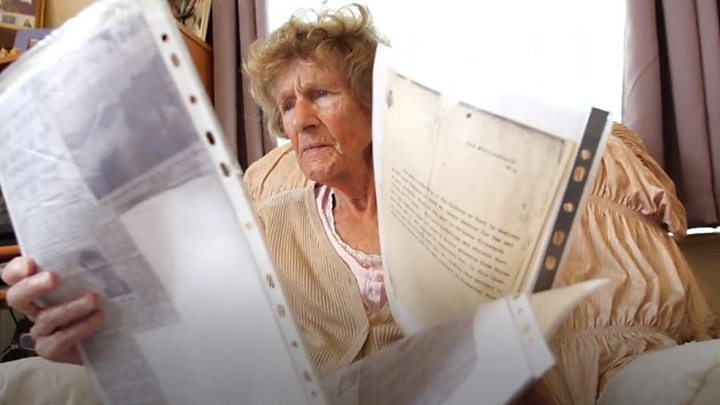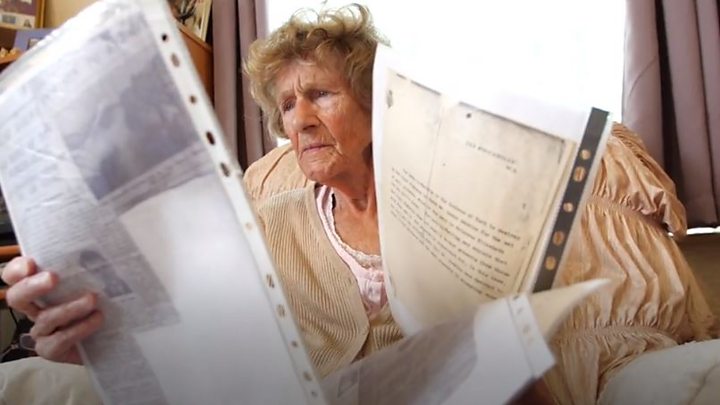The Queen’s miniature house: Welsh artist sent pictures
Attic findings reveal Welsh artist Saxon Jenkins’ links to the Royal Family. …


Media playback is unsupported on your device
His art has been enjoyed by generations of royal children – yet his own daughter knew little of his talents.
Saxon Jenkins, who died in 1989, made paintings of Welsh castles to go in a miniature house given to the Queen when she was six in 1932.
A self-taught artist, he also submitted work to London’s Royal Academy.
But he stopped painting after starting a family and his daughter only found out about his work when her mother died recently and she found clippings.
Margaret Jenkins is now trying to find out more about Saxon’s paintings.
- ‘Devil’s shawl’ painting Salem set for Cardiff auction
- Artist Charles Burton’s milestone Cardiff show and book at 90
A miniature thatched cottage, Y Bwthyn Bach (The Little Cottage), was given to the Queen (then Princess Elizabeth) as a gift from the people of Wales.
Aged 25 in 1932, Saxon read about it in a newspaper, and wondered why nobody had given furnishings to go inside.
So, he painted St Fagans castle near Cardiff and the since demolished Dunraven castle near Southerndown to offer as decorations.
Describing his efforts, he told an unknown newspaper: “I had to perch myself on a ledge of rock above the sea in order to secure a proper view (of Dunraven Castle).
“One day there came a sudden violent storm of rain and wind and I was nearly blown into the sea hundreds of feet below.
“I had to cling to the rock with one hand and save my precious picture with the other, and scramble to safety as best I could in the teeth of a howling gale.”
The efforts were fully appreciated, and the Queen Mother requested he be sent a reply saying the Royal Family didn’t usually accept unsolicited gifts, but on this occasion were happy to.
“There was one time at Easter, we came down for breakfast and he had drawn all the faces on the boiled eggs,” Margaret said.
“Apart from that, there was a painting of a field with a tree and bluebells that was in the my nana’s front room and she used to say ‘your father painted that’.
“They were the only hints he used to be an artist.”
Margaret’s birth coincided with the outbreak of war, and with a young family, she believes he stopped painting to concentrate on providing for his family.
She remembers her dad as a quietly spoken, highly-skilled electrician, who worked in Cardiff’s Ely paper mill and made crystal radios and model trains out of cardboard in his spare time.
A neighbour glowingly referring to him as “a genius” is the only thing that stands out in her mind indicating he was incredibly talented.
She added: “When war broke out in 1943, he was 36.
“It destroyed a lot of things. I don’t think he did any painting after and never mentioned his art.
“He had five girls and one boy and, like everyone else, was busy working and building the country back up.
“If it wasn’t for the war, he could well have been famous.”
He was born Harold David Saxon Jenkins in 1907 in Skewen, Swansea and in 1933 submitted work to London’s Royal Academy.
Different newspapers lavished praise on this oil painting depicting “the changing face of Wales”.
It was of a soon-to-be-destroyed rural thatched cottage, with a despondent-looking old man sitting outside as a motor car sped by.
One clipping said it was “remarkable” how he had captured the light and mood.
Saxon described how he was inspired while cycling from his Cardiff home to Swansea and going out to the Vale of Glamorgan every weekend to draw.
He would stop and sketch scenes before completing landscapes and seascapes.
However, modestly, he told one newspaper: “Art is only a hobby for me so far.
“I am afraid it may never be more than that but it is a delightful hobby all the same, and therefore its own reward.”
When war started, Saxon worked as a policeman in Ely and met his wife, which is when his fledgling art career appears to have ended.
Margaret knew that an aunt in Canada had some of her father’s paintings – but when she died, they also disappeared.
One was donated to Cardiff’s Royal Infirmary in the 1930s, but Margaret fears all traces of his talents have now gone from the wards there as well as everywhere else.




